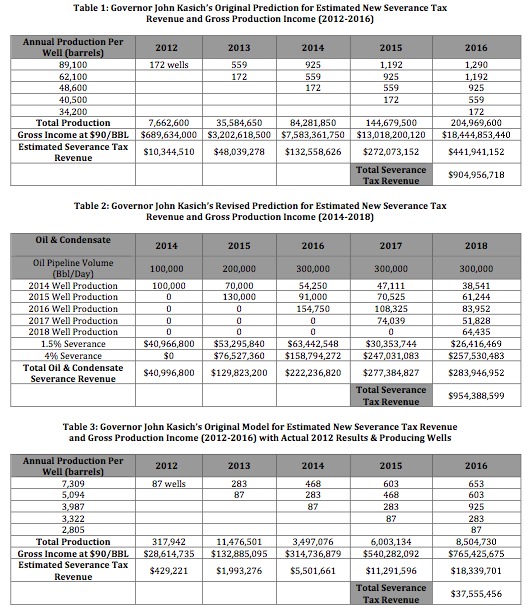By Matt A. Mayer
With the release of the 2012 Utica Shale formation production figures, any discussion of increasing the severance tax on Ohio’s energy entrepreneurs, farmers, and landowners should end. It is time Governor John Kasich acknowledges reality and permanently shelves his tax hike proposal. Any marginal cost increase from higher taxes on the Utica Shale formation will further inhibit future investment and production in Ohio.
Last week, the Ohio Department of Natural Resources released the production figures for 2012, which revealed Ohio’s 87 active wells only produced 635,896 barrels of oil. As reported by Reuters in “Ohio’s Well Data Shatters Shale Oil Hopes”:
[D]ata from Ohio’s Department of Natural Resources (DNR) showed that in 2012, the first full year of drilling, oil output amounted to only 636,000 barrels about enough to fill a single small crude oil tanker. On average for the full year, output came to a mere 1,742 barrels a day (bpd) versus 780,000 bpd in North Dakota, where much of Bakken lies.
“This is less impressive than was initially touted,” said Mark Hanson, energy analyst at Morningstar in Chicago. “It doesn’t look like it’s going to be the next Eagle Ford.”
The facts bear repeating: 87 wells produced 635,895 barrels of oil, or just 7,309 barrels per well for the entire year. The actual production rate and number of producing wells are substantially below the projections in Governor Kasich’s models upon which he bases his severance tax hike proposal.
We focus on oil production because gross income from oil production made up 95.8 percent of the revenue from which Governor Kasich expected to get his severance tax proceeds. Governor Kasich’s original estimate for 2012-2016 projected that the severance tax would raise $904,456,719, as noted in Table 1.
With the weak production results from 2011 as highlighted in “Governor John Kasich’s Claims on His Severance Tax Hike Plan: ‘Exorbitant Overestimates’ Drive Bad Policy,” Governor Kasich revised his projections for the Utica Shale. As detailed in Ohio Tax Commissioner Joseph Testa’s written testimony to the Ohio House Finance and Appropriations Committee, Governor Kasich now predicts the Utica Shale formation will produce 36,500,000 barrels of oil per year in 2014 and reach a peak of 109,500,000 barrels of oil per year by 2016, as noted in Table 2. The total oil revenue expected from this production is $954,388,599, which represents 85 percent of all severance tax revenue projections for 2014-2018.
For Governor Kasich’s revised prediction to come true, based on the actual 2012 well production figures, production would have to increase by 5,640% in just two years and by 17,117% by 2016. Needless to say, it is highly unlikely Ohio will experience an enormous increase in its oil production, especially as energy firms pull out of Ohio or focus on the natural gas opportunity. If the well count is adjusted to reflect the actual number of wells in production and future well count increases at the rate used in Governor Kasich’s original estimate, the total severance tax drops to $38 million from 2012-2016 as noted in Table 3. The revenue collected from 2016 decreases from $442 million to $18 million. Table 3 shows that the severance tax after five years totals just $38 million, a 96 percent decline from Governor Kasich’s original estimate in Table 1.
Even the well count in Table 3 may be too high given that Ohio’s share of drilling rigs is fairly low. According to Baker Hughes, there are only 32 drilling rigs in Ohio. In comparison, Texas has 838, North Dakota has 176, and Pennsylvania has 59. Thankfully, Ohio’s House of Representatives has understood the negative impact higher taxes could have on Utica Shale formation activities and pulled Governor Kasich’s tax increase out of the proposed biennial budget. With the release of the 2012 production figures, let’s hope Governor Kasich soon comes to a similar understanding.
As Kenny Rogers famously sang, “You’ve got to know when to fold ‘em.” For Governor Kasich’s severance tax gamble, that time is now.


